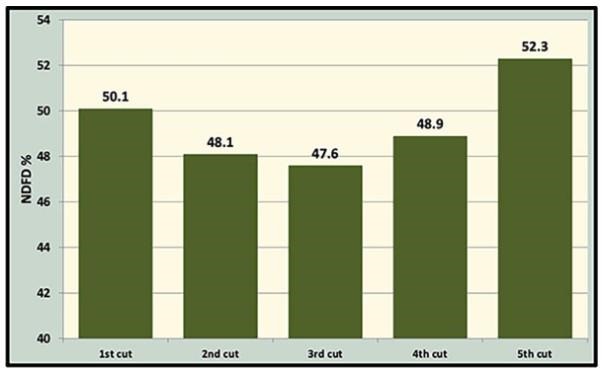By Sara Bauder
Alfalfa has been quite slow to reach the bud or bloom stage for typical South Dakota first cutting timing. If it’s been dry (or at least dry early in the growing season) and temperatures have been below normal, there likely have not been as many growing degree days to get alfalfa up and running as quickly and efficiently as some previous years. This makes determining when to start cutting a bit challenging.
Hay growers should ask themselves the following questions: 1) What are my end goals with consideration to feed value? and 2) What is my target harvest schedule? Common grower objectives include high harvested yields, high nutritive quality or high vigor/stand persistence. We cannot typically have all three of these on one specific harvest schedule, but two may be attainable.
Cuttings and Quality
Frequent harvests that produce higher quality forage at reasonable yields do sacrifice some stand persistence and plant vigor, whereas, longer harvest intervals will produce likely higher yields and better stand longevity, but lower-quality feeds. The first cutting of established alfalfa is typically the best opportunity to harvest the highest concentration of digestible fiber of the season. Cool springs actually help improve this.
For the past 15 years, the University of Wisconsin conducted an alfalfa project that measured yield on 127 different fields over a stand’s productive life. On average, the first cutting had higher neutral detergent fiber digestibility (NDFD) than subsequent cuttings with the exception of a late fall 5th cutting (not common on dryland hay in South Dakota) (Figure 1).

Figure 1. NDFD by cutting in the Wisconsin Yield and Persistence Project Trials (2007-2021).
High-Quality Cutting Systems
Harvest timing of the first cutting can greatly affect the rest of the alfalfa growing season. Forage quality can take a dive quickly, as the plant matures at the first cutting timing, so getting the field cut at bud to late-but stage is key to harvesting the high-quality, digestible feed and leaving enough time for subsequent cuttings. The typical harvest interval for a quality-focused system like this is 32-35 days until late August/early September. A late-fall cut may be added to this system, with the caveat that fall cuttings can be quite hard on stand longevity.
High Tonnage Cutting Systems
If you are more focused on attaining high tonnage rather than highest quality, this first cutting is still quite important! Maximum dry matter yield of alfalfa (and many other forages) is typically obtained by harvesting the first cutting at nearly full bloom and following with a 40-45 day harvest interval until late August or early September. This won’t get you the highest quality feed, but it will typically help achieve higher tonnage with acceptable quality for livestock on maintenance rations or any lower-performance feeding programs. Sometimes growers in this 3-cut system will add a fourth cutting in mid to late October, but again, this can affect stand longevity. Keep in mind that if your alfalfa is quite behind its normal first-cutting schedule this year, consider cutting at an earlier growth stage in hopes of getting all of your typical cuttings in; this is, of course, weather dependent.
Deciding When to Cut
Guessing when to make that first cutting can be difficult, as researchers have determined that using plant maturity or calendar dates alone can be quite risky. Many decide to get the mower out when they see the neighbors hay down. Although this may work, there is a better predictor! At minimum, we suggest looking at the development stage of your alfalfa. For example, at early bud, you cannot see the bud but can feel it at the stem tips, by late bud you can see buds that are just getting ready to open up and bloom. Early bloom is when you just begin to see some color out there, and of course, full bloom is when the entire field is in colorful. Seed-pod stage is fairly obvious, as seeds become visible; at this point, the plant is losing nutritional value quite rapidly with each day of harvest delay.
The most-reliable method to attempt to predict your alfalfa quality is by using a growing degree day calculator (like the one featured on the Mesonet at SDState) or by using a predictor method. There are two predictor methods, the “scissor clip” or the “Predictive Equations for Alfalfa Quality” or PEAQ. Either of these methods can be found online in more detail at many reliable sources. Keep in mind that both predictor methods require you to additionally calculate harvest and storage losses (typically 10-15%), as they are not factored in.
Source : sdstate.edu